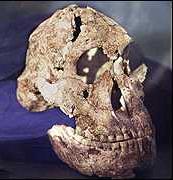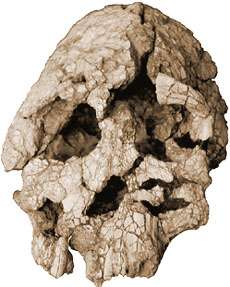
 |
Freethought & Rationalism ArchiveThe archives are read only. |
|
|
#11 |
|
Senior Member
Join Date: Nov 2001
Location: N.Ireland
Posts: 527
|
Haven't read the links yet, so will only be quick with this.
One of the most important "inbetween" pieces - that of ape to man. How come there is no sure evidience of that? Surely there should many many fossils linking us but how come there aren't. If you say Lucy is an example of this - have you seen pictures of Lucy's remains??!! They are so uncomplete it is unbelievable! There are only a few pieces of skull, etc. etc,. So infact does the interpretation of what Lucy was lie completely in man's hands? Does that explain why there are so many differing views? How can you be sure that some of the fossils aren't those that have had harmful mutations and natural selection has eliminated them? One last question ; how could the dinosaurs go extinct and yet more fragile smaller creatures survive? Doesn't that strike you as odd? These are a few questions I have - but as yet I have to look at the links provided and will do that tomorrow. |
|
|
|
|
#12 | |
|
Veteran
Join Date: Aug 2001
Location: Snyder,Texas,USA
Posts: 4,411
|
Quote:
Yes, these explanations may sound like they're "made up" to you. But when you have tons of fossils and libraries of geology that show any rational student that 1) the dinosaurs did die out, 2) the mammals survived, 3) a huge asteroid hit the Yucatan within a geological eyeblink of 1) and 2), it should make that student wonder: "Hmm, I bet there's a connection here!" |
|
|
|
|
|
#13 |
|
Veteran Member
Join Date: Mar 2002
Location: anywhere
Posts: 1,976
|
I just wanted to point out that more accurately, natural selection is the process which confers *differential reproductive success* with respect to particular alleles in a gene pool. It is not entirely correct to say 'survival of the fittest' since sometimes a gene that is not entirely helpful (i.e. the carrier may not be 'fit') may help the individiual survive. One example that comes to mind is the high frequency of the HbS allele in environments in which malaria is rampant.
I just want to point out this inaccuracy because we would be as bad the Creationists are if we spread half-truths. SC |
|
|
|
|
#14 | |||
|
Contributor
Join Date: Sep 2000
Location: Alibi: ego ipse hinc extermino
Posts: 12,591
|
Quote:
 ) David, please could you tell us which of these pictures are of ape skulls, and which ones are human? ) David, please could you tell us which of these pictures are of ape skulls, and which ones are human?Quote:
 Quote:
Two points: Lucy may be remarkably complete for her age (c 3.2my), but she is very far from being the only Australopithecine specimen. And unless one understands rather more than you do about anatomy and palaeontology, you've got no way of realising just how much information can be gleaned from a single tooth, let alone all that lot above. So please take a look at those skulls. Which ones are the ape ones, and which are the human ones? You reckon apes and humans are separate kinds. Show me the dividing line, and say why. Oolon |
|||
|
|
|
|
#15 | |
|
Veteran Member
Join Date: Mar 2001
Location: Louisville, KY, USA
Posts: 1,840
|
Quote:
David, would you mind answering a simple question? What features must be present in a fossil primate for it to qualify as an "in between"? And please give an operational definition that is based on observable anatomical-skeletal features. For instance, what dental, cranio-facial, and post-cranial features should we use to diagnose "in betweens"? Answer this question first, and then we can discuss whether such things exist or not. Thanks, Patrick |
|
|
|
|
|
#16 | ||||
|
Veteran Member
Join Date: Jul 2001
Location: Orion Arm of the Milky Way Galaxy
Posts: 3,092
|
Quote:
Quote:
Quote:
Quote:
|
||||
|
|
|
|
#17 |
|
Veteran Member
Join Date: Jul 2001
Location: Orion Arm of the Milky Way Galaxy
Posts: 3,092
|
Re: Fossil Hominids
David mentions Lucy. I wonder why he does not mention Turkana Boy:  This 90% complete skeleton of a boy that is not a human being and yet so clearly allied with humans. If you want we can go through the un-"human"-like features of the skeleton. Lets return to the australopithicines. Lucy and her species are not the only finds. You can learn about a rather recent find <a href="http://www.talkorigins.org/faqs/homs/littlefoot.html" target="_blank">here</a>. Notice that Little Foot's skull is complete and articulated and with a great deal of the postcrania known. Here is a picture of a robust australopithecine skull from a great new hominid site in South Africa:  I have only given a tiniest fraction of the fossil evidence. |
|
|
|
|
#18 |
|
Contributor
Join Date: Jul 2000
Location: Lebanon, OR, USA
Posts: 16,829
|
The Cretaceous-Tertiary mass extinction is noted for having a "fungal spike" -- a big increase in the concentration of fungus spores, as if fungi had been multiplying at that time. This is consistent with the mass-kill hypothesis, and it also shows that the Earth stayed warm enough for fungi to grow.
This suggests a combination of obscuration and greenhouse effect; the obscuration would kill much of the vegetation, and force much of the rest to stop growing and drop its leaves, while the greenhouse effect would keep it warm enough to decay. The survivors on the land are small warm-blooded animals (mammals and birds at the time) and cold-blooded ones (invertebrates, frogs, salamanders, turtles, lizards, snakes, and crocodilians). These have in common having a relatively small appetite compared to big warm-blooded animals, which many dinosaurs apparently were. The small warm-blooded ones simply because they were small, and the cold-blooded ones because they did not have to continuously eat. So what may have happened is: Meteorite hits Puts up lots of haze and CO2 Which darkens the Earth and keeps it warm Which kills many plants and plant parts Which deprives the animals of food Which drives to extinction those with big appetites |
|
|
|
|
#19 |
|
Veteran Member
Join Date: Jul 2001
Location: Orion Arm of the Milky Way Galaxy
Posts: 3,092
|
Some more hominids.
Here is a different species of robust australopithecine:  Here is a recent skull that was published last year:  A gracile australopithicine:  A habiline fossil:  And another habiline:  I could go on for a long time. [ March 03, 2002: Message edited by: LordValentine ]</p> |
|
|
|
|
#20 |
|
Veteran Member
Join Date: Jul 2001
Location: Orion Arm of the Milky Way Galaxy
Posts: 3,092
|
How about a neandertal?
|
|
|
| Thread Tools | Search this Thread |
|